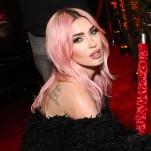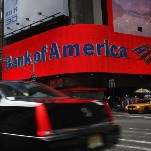Be Afraid
LatestYou might remember (or rather, you might have struggled to forget) “Fearless Girl,” a 50-inch bronze statue of a girl, hands on her hips, skirt blowing in the imagined, perpetual wind, installed the day before this past International Women’s Day on Wall Street, staring down that same street’s iconic bull.
“Look at that metal girl,” the internet gasped. “Look how fearless she is in the face of an also-metal bull; neither of them have a brain or real kind of body and yet still I am full of awe.”
Fearless Girl became iconic of a particular brand of extremely broad, commercialized feminism—one that doesn’t care about action as much as it cares about signaling that the social media user is hip to the conversation and sympathetic to the Right causes. This connotation was solidified, boringly, when it came out in October that State Street, the financial services firm that had installed the statue would pay $5 million to settle claims that it paid over 300 top women employees less than it did men in the same positions.
this year, that real, material fear has been co-opted and rebranded
This little symbol wasn’t the only venture with less-than-pure motives to employ the idea—now cliché—of the “fearless woman.” In fact, it has been hard to avoid it. This year, website Refinery 29 used the word “fearless” with seeming abandon—a participant in a smoothie challenge, a body positivity advocate, a quest for a nose stud, Gordon Ramsay, and, perplexingly, a fictional character’s nihilism. The Showtime show SMILF about a single mother used the advertising tagline, “Functional sometimes. Fearless always.” Forbes published a list of “Fearless female founders to follow in 2018.” Adidas launched their “Fearless AF” campaign meant to shine a light on “badass” (yet another meaningless word) female runners. Fabletics, Kate Hudson’s athleisure brand, also has a “Fearless” campaign from earlier. So does Victoria’s Secret, as well as a collection of similarly-named lip glosses and perfumes. Deodorant can also allegedly help women feel fearless, so can shoes, and this planner. Columbia Journalism Review even referenced Jezebel’s “fearless feminist reporting.”
But anyone who has actually been paying attention in 2017 knows that it hasn’t been the year of the fearless woman—for many of us, it’s been a year of constant, unchecked anxiety and an honest assessment of the state of Americans would have similar findings.
NBC News reports that college students are more anxious and depressed than ever; A Centers for Disease Control and Prevention study found that the number of Americans with serious psychological distress has also risen to 8.3 million. Washington Post columnist Dana Milbank writes about an upcoming paper in the journal “Psychoanalytic Perspectives” that deals specifically, if anecdotally, with the spike in psychological distress since the election:
-

-

-

-

-

-

-

-

-

-

-

-

-

-

-

-

-

-

-

-

-

-

-

-

-

-

-

-

-

-

-

-

-

-

-

-

-

-

-

-








































